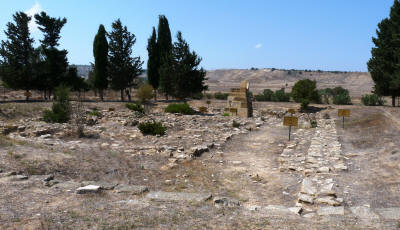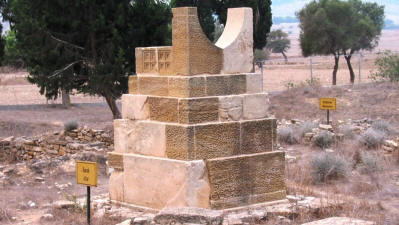Pigadhes Bronze Age Sanctuary
Camlibel, Near Guzelyurt, North Cyprus
 |
| Pigadhes |
Set back from the road near Camlibel, you will find the shrine of Pigadhes. Like its neighbour, Tumba Tou, it dates to around the early Bronze Age.
The site was first discovered in 1949, when villagers, digging for a well, discovered pottery fragments. Excavation, started in 1950, uncovered the courtyard sanctuary, of which only a few are known. The site appears to have been first occupied around 1700BC, although there are no structures remaining from that time.
The excavation is quite small, covering around 400 square yards, with most of the unearthed stone at ground level. There is a well and some walls which appear to be rooms round a central garden.
The walls that can be seen date to around 1500BC, the originals probably being destroyed by earthquake. Below the courtyard, you can see four rooms with squared rubble walls. To the east, more rooms were added at a later date. These yielded some interesting finds; three bronze tripods, two ring stands, several incense stands, and an inscribed jug.
 |
| Pigadhes Alter |
The courtyard was built on top of earlier buildings, with a road leading in from the east. There were probably rooms at a higher level, but these have long ago been ploughed over. Trial excavations would indicate that the site was a large settlement as well as a sanctuary. Finds in this area have been dated from 1000BC to 800BC, but there is no evidence of occupation after this date.
The most significant structure is the Altar, standing in the central courtyard. It is not original, but has been built in the style of the time. It has a thick stone base, on top of which, at about two and a half meters, are stone horn-like features where, it is thought, animal sacrifices were offered to the gods.
It is a very quiet place, and although fenced off, there is no entrance charge.
To reach Pigadhes, take the road from Camlibel towards Nicosia. Three kilometres from the junction with the road towards Guzelyurt, you will catch a glimpse of Pigadhes, in the middle of a field ,surrounded by cypress trees. There is a track leading to the site, but take care leaving the main road as you have to traverse a drainage ditch.
See the location on Google maps
Back to Guzelyurt index.